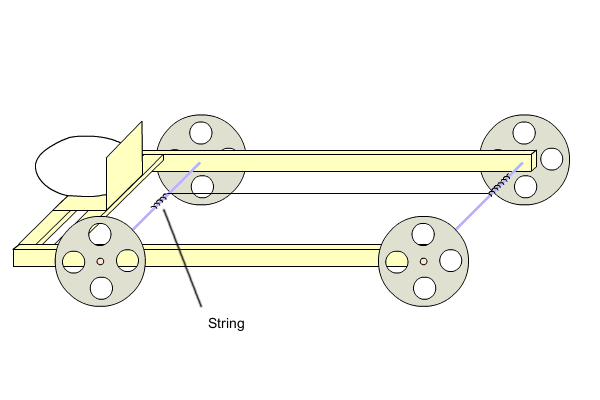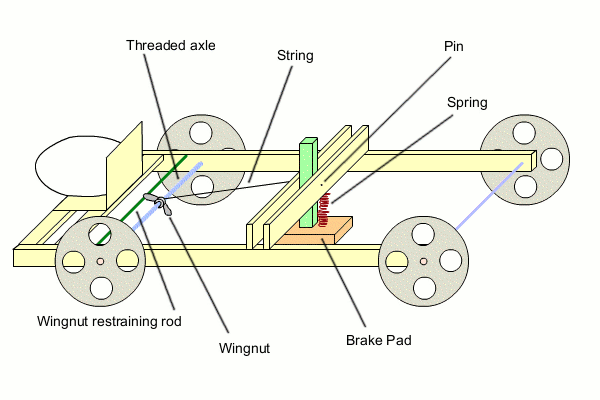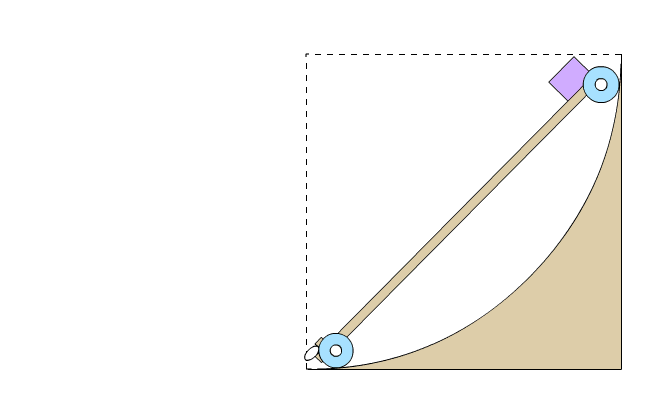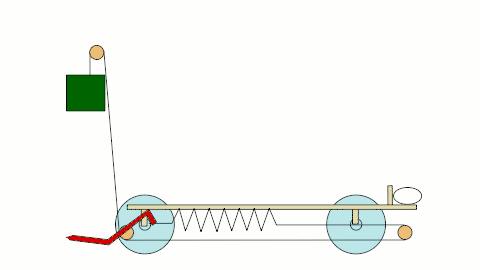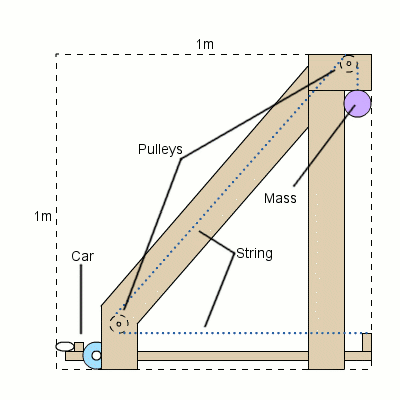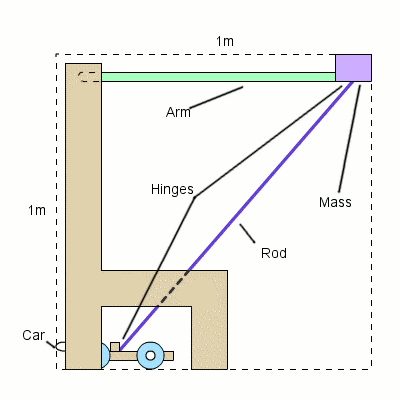User:Raxu
raxu is currently a Division C competitor at Scarsdale High School and Captain of the team in 2017 and 2018. He also competed in Division B for the Scarsdale Middle School team in 2014.
Sandbox
This section contains some physics concepts in areas. The physics is intended to help in the design of the device, especially for Division C competitors, and is not a required part of the event.
While varied, most devices used for this event share some general parts.
Wheels
The wheel is one of the most critical components of the ETV. There are several properties of the wheel that are important to consider for the purposes that it is used in this event.
Material Considerations
Given the limited budgets of most teams, physics has to be eclipsed by the availability of the materials. Most teams use some pre-made disks for their wheels, for example, CD/LP based wheels. Some use roller blade wheels. Better funded teams may wield custom made acrylic wheels, or even those cut from sheets of balsa.
Reducing weight
Lighter wheels are generally better (see physics explanation below). Therefore, given good drilling equipment, it is advisable to drill a series of holes in the wheel to make it lighter. Take care to do it in a symmetrical fashion, and not to weaken the wheel too much. By the physics, the greatest effect shall be seen from reducing the weight of the rims of the wheel. Look at the professional wheels for guidance. For example, high-speed bicycles often have very efficient designs for their wheels.
Most designs drill up to four holes on each wheel, all of the same size. Drilling holes work well with materials like Plexiglas, milled aluminum, steel, etc. However, it does not work with materials like CD and fibrous alloys because it ruins the structural integrity of the wheel.
Friction in the wheel
To reduce the axle friction, teams use ball bearings. These gadgets, while sometimes expensive and tough to find, will often nullify any problems associated with small wheels. Keep these free from dust and well lubricated with grease or other lubricants.
To increase traction, many teams use rubber bands around their wheel rims. Latex gloves as a faster and easier alternative to rubber. The rules prohibit any lasting glues from being used for traction purposes.
In general, it is good to make sure that the wheels are straight, the axles are straight, and the bearings are mounted square to the car's chassis. This helps the ETV move in a straight line.
Physics Theory of the wheel
Below is the theory of physics of the wheel, which may help in the design of the device.
The wheel's mass, specifically its rotational inertia, is one of the most important for an ETV: the rotational energy of the wheel does not accelerate the ETV forward. Let [math]\omega, v, r, m, I[/math] denote the angular velocity, translational velocity, radius, mass and moment of inertia of the wheel, respectively. Since [math]\omega = \frac{v}{r}[/math] and [math]I=mr^2[/math] if we approximate wheels as hollow cylinders,
Therefore, given a constant starting energy, an increase in mass will cause the ETV to have less translational kinetic energy. Since [math]m\propto r[/math], smaller wheels make the car go faster. Wheels that are solid disks have moment of inertia [math]I=\frac12mr^2[/math], but have much more mass and is therefore ineffective.
A larger wheel have different benefits. Smaller wheels allow for your ETV to move faster, but they are more susceptible to axle friction because the wheel-to-axle ratio is lower. ETV with small wheels may fail to reach the target distance just because of friction. Ways to reduce this friction will be discussed shortly. Teams with large wheeled ETV move slower, but at roughly constant speeds. The wheel radius is also important to one of the integrated mass ETV discussed later.
The second important aspect of a wheel in a ETV is its traction. Traction, also known as static friction, is important for the car's stability, and when the wheels are used as brakes, for its braking. The friction between the wheel and the ground is static friction, unless the wheel is skidding. Since the weight of the car is supported by the wheels, the traction is at most
where [math]f[/math] is the force of friction, [math]m[/math] is the mass that the wheel supports, [math]\mu_s[/math] is the coefficient of static friction and [math]a[/math] is the acceleration of the ETV. Beyond the maximum acceleration, the cart will start skidding.
Therefore, the wheel should have higher coefficient of friction to increase its maximum possible acceleration before skidding.
Brakes
If the ETV hits the wall at faster than about 1 m/s, the egg is very likely to break. Therefore, once the car can travel the required distance, a brake should be used to stop the car before it reaches the wall.
Here are three commonly used braking systems, listed in order of difficulty of construction.
String Type
Pros
- Easy to build
Cons
- Poor Accuracy
- Backlash
- Skid
The first braking design is made by running a string from one axle to another. As the car travels, the string from one axle unwinds and wraps around the second axle. Once all of the string has fed through from one axle to the another the axles lock and the car stops. The distance the car travels can be controlled by the amount of string wrapped around each axle.
This design tends to have poor accuracy for several reasons. First, the string used will often stretch in an irregular way. Second, the string will not always wrap in exactly the same manner, meaning there is a slight variation in the amount of travel allowed before stopping the car. Third, while the taut string will prevent the car from moving forwards, nothing prevents the car from moving backward. So, you will get some amount of backlash.
This system relies on the braking power of the rims of the wheels, which may lead to skid, as this design does not allow for gradual locking of the wheels. That being said, this is the easiest system to implement. So, if a quick solution is needed, this is certainly an option.
Threaded Rod Type
Pros
- High accuracy
- Consistency
- No Backlash
Cons
- Somewhat complicated to build
- Skid
- Added friction to the axles
This system is very popular among competitors. While only slightly more complicated than the string method, it is more consistent.
The basic concept of this design is using a threaded rod for the axle, placing a nut (usually a wing nut is used) on the axle. As the wheels rotate the rotating motion is transferred into horizontal motion of a wing nut moving it along the axle. When the wing nut reaches a barrier, it will no longer be able to move and thus stops the axle from turning. The distance is set by setting how far the wing nut starts from the barrier and is usually measured in rotations of the wheels.
While as described the system is still vulnerable to skid, it can be minimized by carefully choosing a material for the barrier that the wing nut engages during the stopping motion. By choosing something rubbery many teams achieved a gradual locking of the wheels, which effectively eliminated any skid inherent to the system. The wing nut also adds some friction to the axle, thus the car may not roll as smoothly or as far.
Brake Pad Type
Brake pads are not allowed in 2017, because the only parts that are allowed to contact the floor are those that are already in contact before the run.
Brake Pad Type (Illegal for Current Rules)
Pros
Cons
This braking system introduces a braking surface, or pad, that is used to stop the car. Unlike the other two designs, there is no standard method of constructing this design although most of them are based on the threaded rod braking system. The concept of this design begins the same as that of the threaded rod design, but rather than relying on the wing nut to jam the wheels and slow the car to a halt, it uses the wing nut to somehow trigger the lowering of the braking pad. The actual methods that the teams use to accomplish this varies, some rely on the wing nut to pull out a restraining pin directly, others have it be pushed aside through a system of levers. By adding a surface that can, in theory, have a greater coefficient of friction than the wheel rims, the stopping performance can be improved. As the brake pad can be located anywhere on the car, the braking efficiency can be maximized, leading to many of these designs to be able to stop almost instantly without any skid. Another advantage of this method is that attempting this design carries a fairly low risk because it can be reduced to the basic threaded rod design fairly easily if you cannot get the system to work. Most attempts use a wingnut to trigger. |
Physics Theory of the break
We expand the theory of friction in wheels described in the wheels section. There are four main questions that must be considered during the design of a braking system of a ETV: how long to make the car, where to put the center of mass, which wheels (front versus back) work better for braking and how to avoid skidding. To answer these questions, we shall consider a simple model of a braking car.
In the picture, [math]N_1, N_2[/math] are the normal forces exerted by the floor on the back and front wheels, respectively. [math]F_1, F_2[/math] are the resulting forces of friction. [math]b, B[/math] are the horizontal distance from the back axle to the center of mass of the ETV and the front axle, respectively. [math]h[/math] is the height of the center of mass, [math]m[/math] is the mass of the ETV. Since the ETV is at equilibrium,
Furthermore, [math]F_1 = \mu_1 N_1, F_2 = \mu_2 N_2.[/math] Two coefficients [math]\mu[/math] are used, because one pair of wheels is used for friction. Solving for [math]N_1, N_2[/math],
[math]\begin{cases}N_1 = M g \frac {B - b - h \mu_2} {B + h\left(\mu_1 - \mu_2\right)} \\ N_2 = M g \frac {h \mu_1 + b} {B + h\left(\mu_1 - \mu_2\right)}\end{cases}[/math]
If one of the normal forces is calculated to be negative in the design, one of the axle loses contact and the ETV is rotating - the ETV is unstable.
An ETV starts skidding if the force applied by the brake exceeds the maximal static friction, [math]F_1+F_2[/math]. If the ETV skids, the kinetic friction is much smaller than the maximum static friction and is dependent on the floor of the competition. Thus, a breaking system with skidding is imprecise and ineffective.
We now determine which axle is better for breaking. If the front axle is used, [math]F_1=0,\ N_2 = M g \frac {b} {B - h \mu_2}[/math]
The maximum normal force occurs when b = B - h k2. This puts the center of mass as close as it can be without reducing [math]N_1[/math] to less than 0. [math]N_{2max} = M g \frac {B - h \mu_2} {B - h \mu_2} = M g[/math]
If the back axle is used, [math]F_2=0,\ N_1 = M g \frac {B - b} {B + h \mu_1}[/math]
In this case the maximal normal force happens when b = 0. [math]N_{1max} = M g \frac {B} {B + h \mu_1}[/math]
Since the ratio [math]\frac{B}{B + h\mu_1}[/math] is always less than 1, [math]N_{1max}<N_{2max}[/math]. Therefore, given a choice of using exclusively the front or the back axle, the front axle should be used. However, the ETV may flip over before the maximal normal force can be reached. A lower height and longer length will prevent the cart from flipping over. However, in some cases it is impossible to have the center of mass be located anywhere near the front of the car (e.g. on a ramp scrambler). Furthermore, back breaking systems do not flip over as easily.
If both the back and front axles are used for breaking, for example if we set the k's to be equal, then the total normal force is [math]mg[/math] and we are back to the original equation. Notice that [math]N=N_{1,max}[/math], and the center of mass does not have to be in the front. Therefore, a design using both axles can be very beneficial.
To summarize, the best braking system involves the use of both axles. The next best choice is the front axle only braking system, which requires a car to be long and low. The least favorable choice is a back axle only system, but it is stable, like the one using both axles, and easier to design.
It should be noted that having high coefficients of friction (while staying in the rule constraints) will make even sub-optimal brake geometry perform well. This makes the choice of location for the brake pad (wheel based brakes cannot easily utilize adhesives) less important. It also prevents the ETV from skidding.
Finally, the actual length of the car is not important in the stability of the system: the distance from axle to axle is.
Mass Release Mechanism
While optional, the mass release mechanism improves the consistency of the scramblers. Its use negates the necessity of steady hands of the person who is handling the mass and allows for near constant launch speeds. This generally improves the performance of brakes that are strongly dependent on the speed of the ETV, such as the wing-nut braking mechanism. A common design for such a device is a pin system, where the mass is suspended on a pin that can be pulled out to produce a consistent release of the mass.
Rollers
Many of these designs involve rollers that redirect strings. They are commonly referred to as pulleys as well, although that is somewhat dubious. The important consideration for these devices is their friction, or rather, its absence. This cannot be the case if the roller does not contain a bearing in it. The advantage of a bearing is that the friction remains roughly constant irrespective of the load that the roller is forced to bear. If a bearing is absent, then the equation (3) applies, which can prove catastrophic is large tensions are used (this assumes an unlubricated bearing, with a lubricated bearing the friction, will decrease once the speed of the bearing surfaces is high enough to cause hydrodynamic forces to float the bearing surfaces apart). Whether a roller has a bearing in it or not can easily be tested. Take a string and try using the roller to redirect the string while pulling on it. If when varying the tension the resistance also varies, then there is no bearing in that roller. Avoid it and buy a roller that has one.
Bearings
As discussed above, bearings are constant (low) friction devices. They are indispensable in rollers, and often are very helpful to hold axles of wheels (especially for the small wheels). The best bearing for this event would be a radial bearing, with caged balls. It is also preferable to have it be free of the side shields: it is easy for teams to keep them dust free, and by lubricating them regularly the low friction can be maintained very easily.
Energy Propultion Systems
This User requires cleanup to meet the wiki's quality standards. |
There are two types of scramblers, based on whether the ETV stays in contact with the mass. In an integrated mass scrambler, the ETV always stay in contact with the mass. The mass may be used to accelerate the car throughout the run, or it is not discarded just to simplify the design. In a launcher system, the ETV is separate from the launcher.
Integrated Mass
These types of vehicles have come into question as to being legal under the 2014 rules
In an integrated mass scrambler, the mass moves with the ETV: the Energy Propulsion System is likely combined with the scrambler. Because the mass travels with the ETV, the ETV cannot move quickly.
Since all kinetic energy of the ETV comes from the potential energy of the mass,
Furthermore, [math]\frac{m_{mass}}{m_{car}}<1[/math] and [math]h\le 1m[/math]. solving for [math]v[/math], we find
Although [math]4.43m/s[/math] is fairly fast, the actual speed is much lower because the mass cannot fall for 1 m total, the ETV has mass, and there is energy loss due to friction in the process.
Tower Scrambler
Pros
- Reasonably easy to build
- Good theoretical performance
- Can be almost free to build - see Zero Cost Scrambler
Cons
- Theoretical performance impossible to achieve, so much so that often the required distance cannot be covered
- Manufacture of the variable radius axles can be challenging
- Severe dependence on mass used
A relic of the times when only single part devices were allowed, this integrated mass launcher consists of a car that is propelled by a falling mass that uses a pulley system or otherwise to directly convert the motion of the weight into the motion of the car. This scrambler obeys the equation (10) reasonably well. However, the approximation of equating the mass of the car to the mass of the mass is impossible to make in this case. The support structure for the mass and the pulley system (not to mention the wheels) often drive the masses of these scramblers above 5 kilograms. This makes these scramblers very slow. As such, it is difficult to build the scrambler to cover the whole distance. Also, they are normally slower than launchers.
Unique to this design is a braking system that involves the mass simply hitting the ground, perhaps assisted by a braking pad. This brake is severely dependent on the speed of the scrambler, which in part is dependent on the surface of the scrambler, making it unreliable for close-to-wall stopping.
The modus operandi of this device is the torque transfer from the torque provided by the falling mass, to the torque imparted on the floor surface by the wheels. The torques can be related by the simple equation:
- [math]M_g r_1 = F_f r_2[/math]
M - the mass of the mass; r1 - radius of the axle; r2 - radius of the wheel; Ff - force imparted onto the ground.
The Ff force is the force that pushes the device forward. It would appear that ideally, you would have a very small radius of the wheel and a very large radius of the axle to maximize the Ff. However, the Ff can never exceed the force of static friction that the wheels feel touching the ground. If it exceeds it, then the wheels will skid and the scrambler will not move. This places a practical limit on how small one can make the wheels. This can be helped a bit by increasing the traction between the wheels and the ground, which will allow for smaller wheels. It should also be noted that smoother force curves are preferred for this scrambler type. Often by making the Ff small and thus allowing for more time for the weight to accelerate the car one can avoid the problems associated with the imperfection of the materials: if you increase the Ff too much, the strings may start acting as springs. It is, however, difficult to predict what will happen using physics alone and thus it is advisable to test various ratios of axle to wheel radii.
To improve performance, teams sometimes use variable radius axles. Generally they are set up to provide a large torque at the start to get the scrambler moving (i.e. a large r1 from equation (11)). Then as the scrambler advances, the radius of the axle decreases thus providing more acceleration, as at this point the forces of static friction are less pronounced. This fact makes theoretical predictions to be very hard for these types of devices, and thus none are provided.
Ramp Scrambler
Ram Scramblers are not allowed in 2017: all ETV wheels must be in contact with the floor at all times.
Ramp Scrambler (Illegal under current rules)
Pros
Cons
(Note that the entire car is counted as the mass during impoundment) This integrated mass scrambler consists of a car with a mass attached to it that rolls down a ramp and continues onto towards the wall. This scrambler is very accurately approximated by the equation (10). This scrambler is arguably the easiest one to build, although it always runs into the trouble when putting the front of the egg on the start of the line. This can is often avoided by using very long cars. It is well known from the derivations by Newton et al that the ramp shape that allows for a mass to descend in the shortest time, a brachistochrone, is a 4 pointed astroid. This curve is difficult to get perfect, and through some calculations, it can be seen that pretty much any curve that approximately looks like a quarter circle will do just as well. Note that from physics it is known that the car will do best if its mass is concentrated in the back (thus starting higher on the ramp). This presents many problems for braking, as discussed in the braking section above, as this is exactly the opposite of what is desired for a front braking car. However, there are teams that do well with this design, and it represents a valid choice. Note that this scrambler is often classified as a launcher type, citing the fact that the ramp acts as a launcher, and that this type was not allowed by the rules from years that did not allow for multipart launchers. However, this scrambler obeys the equation (10) which takes precedence. Here are some numbers that can be calculated from simple physics. These calculations assume a perfect design and no friction. Distance is set at 10 meters. The mass of the car is set at the mass of the weight. They also assume that all of the mass of all three vehicles is centered at the same single point in space, actually, the more massive vehicles are likely to have a higher center of mass so they would actually exit the launcher at a higher speed. *
*A note about these and future numbers: The car assembly (car and the egg) are assumed to weigh 150 grams (unless stated otherwise). The brake is assumed to be instantaneous. The distance is assumed to be 10 meters. Note that these values will never be achieved since they assume no friction and mildly unrealistic design choices, but the patterns can still be observed and the inter-type comparison can still be made. The idle time represents the time needed for the device to prepare itself, be it cocking of the spring in the spring launcher, or the falling of the hammer in the hammer launcher. The acceleration time column represents the time the device spends accelerating the car; this is different from the idle time because the car is actually moving during this point. The exit speed represents the speed at which the car is moving after it leaves the launcher. The travel time is the time the car takes to travel the distance from the launcher to the wall (this may or may not equal to the assumed distance of 10 meters since some launchers push the car forward of the starting line as part of their acceleration routine). The three rows signify the masses of the weight that is used to power the device. |
Launcher
An Introduction from Physics
Launcher type scramblers without exception are characterized by the existence of a device separate from the car that is designed solely for the purpose of converting the potential energy of the mass into the kinetic energy of the car. This, unsurprisingly, means that means that this type of scrambler is easily simulated by the equation (10). The advantage that these systems possess over the integrated mass scrambler type is that the little m in that equation can be smaller than the big M.
Spring Launcher
Pros
- Nearly maximum theoretical efficiency possible in a scrambler
- Reasonably easy to achieve the theoretical performance
- Low dependence on mass used
Cons
- The locking mechanisms are often difficult to build
- Complexity of the device requires careful construction
- Rapid speed of the car makes it difficult to stop
Spring launcher is one of the rarest launcher scrambler types, often sighted alone in competitions. Being a very complicated design, it is often misbuilt by teams, and thus gets a bad reputation. However, it easily achieves the highest speeds for scrambler cars, at all distances and most masses.
Its mode of operation is simple in theory. The mass first stores its potential energy in some sort of elastic medium, be it a spring or a rubber band, which then is released to accelerate the car. This decoupling of the mass and the car allows for the equation (10) to be obeyed very closely. M does indeed represent solely the mass of the mass, m does indeed represent solely the mass of the car. It is there that the speed of this launcher lies, as one makes the mass of the car smaller, no limiting speed is approached, unlike other scrambler types.
In practice, however, the above is difficult to build. Some teams use masses attached to arms with slits in them that allow for a looped string to slip and release the spring once a particular angle is attained by the arm. Some teams build a more sophisticated system of coupled locks (as depicted in the diagram) to mediate the energy transfer.
Superficially, a true spring launcher is very similar to a pulley launcher, and thus if the spring experiment fails, it can be easily down-graded to a functioning pulley launcher.
When operating this launcher, teams often observe a noticeable time spent on the launcher charging itself up (performing the energy transfer from the mass to the spring). This can be disconcerting, but often the speed obtained makes up the difference. This property makes the spring launchers behave better at longer track lengths.
Another problem unique to this launcher is that the car is launched at such a great speed, that most brakes used for other, slower, launchers are inadequate for this design. Due to the rarity of this design, no general solution to this problem has been posed, but the theory does not forbid a solution from existing.
The following are some numbers derived from physics. Note that this launcher pushes the car forward 1 meter before it is set free.*
Assuming Vehicle Mass of 100 grams
Total Time is from .5m to 8.5m.
| Mass | Exit Speed | Total Time |
|---|---|---|
| 0.5 kg | 9.90 m/s | 0.81 sec |
| 1.0 kg | 14.00 m/s | 0.57 sec |
| 2.0 kg | 19.80 m/s | 0.41 sec |
Look at Jdogg's post on the Scrambler forum page for more info on this chart above.
Hammer Launcher
Pros
- High theoretical efficiency
- Very easy to build
Cons
- High dependence on mass used
- Theoretical efficiency is difficult to achieve, due to the non-truly elastic collisions
- The rapid acceleration is stressful on the car, requiring it to be sturdy
- There is a chance that (due to the force of impact), the yolk of the egg is ejected from the shell at the moment of impact, resulting in a tiered run
Hammer launcher is one of the easiest launchers you can build. It consists of a pendulum hammer falling and smashing a car from the behind. The momentum is exchanged, and the usually light car is accelerated to high speeds.
From physics it is known that a perfectly elastic collision is simulated by the following equation:
- [math]v_1 = \frac {2M} {M + m} \times v_2[/math]
v1 = velocity of the car; v2 = velocity of the mass; M = mass of the mass; m = mass of the car
It is clear from this formula that the larger the difference between the two masses is, the faster the car will go. The limiting scenario is when the mass of the car is nonexistent, which makes it go at double the speed of the mass. We know the speed of the mass from the equation (10) when we set the big M and small m to be equal: 4.42m/s. Thus, the maximum possible speed achievable by a car launched by this launcher is an amazing 8.84m/s.
That speed, however, is unattainable, since the car cannot be massless and the collision involved is seldom perfectly elastic. Light cars can easily alleviate the first problem. The second problem is solved in various ways by teams. By varying the materials at the contact position the elasticity of collisions can be enhanced. Many teams have trouble keeping their small car from launching at an angle. Some teams did manage to negate this problem by using longer cars that have the hammer hit a patch that is located in between their wheels.
The mass of the entire arm must be weighed during the impounding since most designs have the arm lose its potential energy as a whole. From physics it is known that to achieve optimum efficiency, most of the mass of the arm must be concentrated at its distal end, thus making most teams using a hammer/mallet like arrangement. Here are some theoretical data.*
| Mass | Idle Time | Acceleration Time | Exit Speed | Travel Time | Total Time |
|---|---|---|---|---|---|
| 0.5 kg | 0.59 sec | 0.00 sec | 6.81 m/s | 1.46 sec | 2.06 sec |
| 1.0 kg | 0.59 sec | 0.00 sec | 7.70 m/s | 1.29 sec | 1.89 sec |
| 2.0 kg | 0.59 sec | 0.00 sec | 8.24 m/s | 1.21 sec | 1.81 sec |
Pulley Launcher
Pros
- Good theoretical efficiency
- Easy to achieve theoretical efficiency
- Simple construction
Cons
- Some dependence on mass used
The pulley launcher is one the most common launcher designs used for this event. It consists of a mass pulling a string that is redirected through a system of pulleys to pull the car. This design is popular for several reasons, it is easy to build, it is efficient and teams who use it have done well in the past. The physics of this device are covered in any decent physics class, and are simulated by the following equation:
- [math]M g = \left(M + m\right) a[/math]
M = mass of the mass; g = acceleration due to gravity (9.8m/s2); m = mass of the car; a = acceleration of the car
It can be seen that by making the mass of the car small, an asymptotic acceleration of g is quickly obtained. As we know, when the acceleration is g then the maximum speed is 4.42m/s.
The fact that this launcher involves no true energy transfers, any deviation from the theoretical performance is explained away by friction in the rollers and wheels. Since those can be easily fixed, these scramblers are often the faster half of launchers in any given competition.
Here are some theoretical data from physics. Note that this launcher pushes the car about .7 meter before releasing it.*
| Mass | Idle Time | Acceleration Time | Exit Speed | Travel Time | Total Time* |
|---|---|---|---|---|---|
| 0.5 kg | 0.00 sec | 0.51 sec | 3.88 m/s | 2.32 sec | 2.83 sec |
| 1.0 kg | 0.00 sec | 0.48 sec | 4.13 m/s | 2.18 sec | 2.66 sec |
| 2.0 kg | 0.00 sec | 0.47 sec | 4.27 m/s | 2.11 sec | 2.57 sec |
- Actual speeds a somewhat slower this year due to .75 meter height restriction. Maximum possible speed for this launcher with a zero mass scambler is about 3.75 m/s. with a 1.5KG mass and a 100-gram scambler, the max speed of the scrambler would be less than 3.5 m/s, although as the mass of the vehicle gets small compared to the falling mass there become less and less change in velocity as the mass of the scramble decreases.
Push Rod Launcher
Push pod launchers are not allowed in 2017, because the only parts that are allowed to contact the floor are those that are already in contact before the run.
Push Rod Launcher
Cons
A common design for a launcher, this launcher is seen in large numbers in some competitions. There is no reason for this popularity however, this launcher cannot be better than a pulley launcher, and as shall be shown it is worse. The launcher consists of a hammer arm akin to the one from a hammer launcher connected by a rod to the car. Thus as the hammer swings down, the car is pushed forward by the rod. The physics of this system are highly complicated, and cannot be simulated by high school physics, thus any theoretical analysis will have to be gleaned from the theoretical data at the end of this section. Practically speaking, the difficulty in attaining the theoretical efficiency of this launcher lies in the fact that both the arm and the rod are not massless, and by diluting the concentration of the mass at the distal end of the arm, they quickly reduce the efficiency of this launcher. As always, the entire mass of the arm and rod assembly must be weighed during the impoundment. Here are some theoretical data for this launcher. Due to the rod length, the car is pushed a full 1.4 meters forward before being released.*
The 2015 rules prohibit any part of the Scrambler (energy providing device and car) cannot touch the floor at any point after the launch. Violating this rule will result in a construction violation, which is a penalty of 3000 points. As shown by the above animations, there is a chance that the rod will contact the ground after the vehicle is moving of its own accord. Teams should take this rule change into consideration if this is the final design chosen (i.e. have the push rod attached to the vehicle so when the car is launched, the rod comes off the mass and with the car, not touching the floor). |


